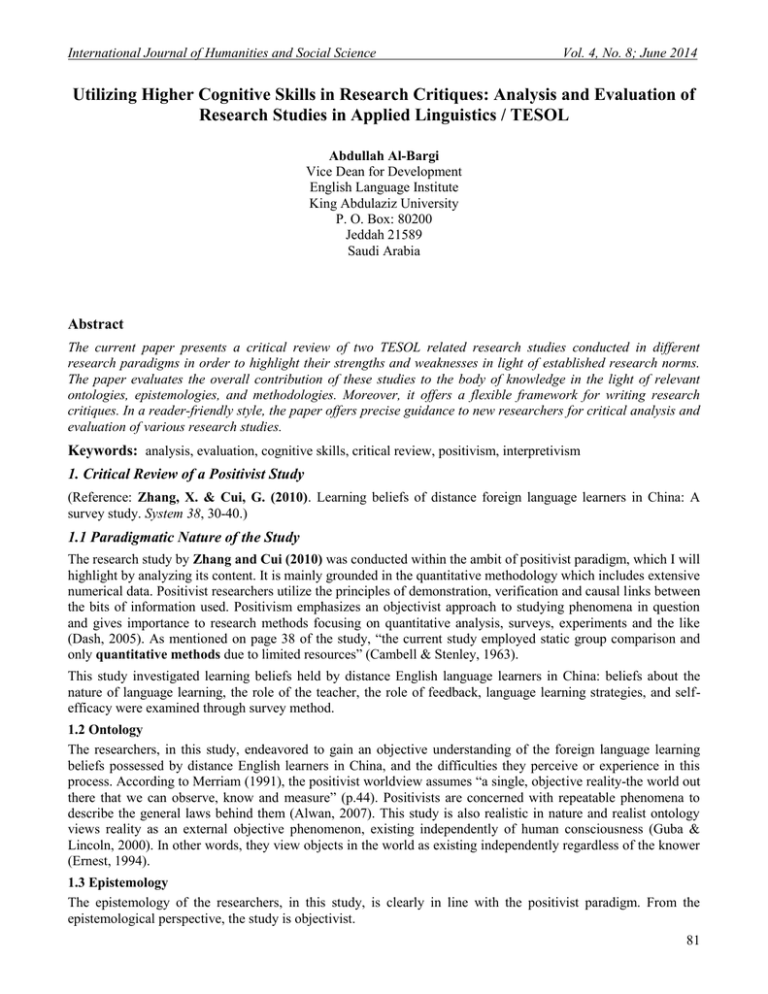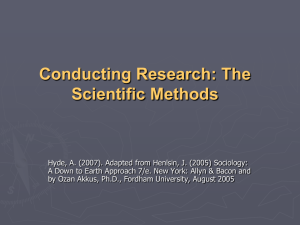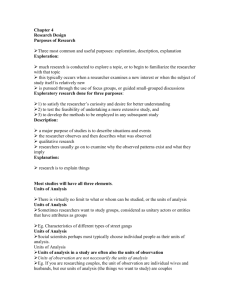Document 10465771
advertisement

International Journal of Humanities and Social Science Vol. 4, No. 8; June 2014 Utilizing Higher Cognitive Skills in Research Critiques: Analysis and Evaluation of Research Studies in Applied Linguistics / TESOL Abdullah Al-Bargi Vice Dean for Development English Language Institute King Abdulaziz University P. O. Box: 80200 Jeddah 21589 Saudi Arabia Abstract The current paper presents a critical review of two TESOL related research studies conducted in different research paradigms in order to highlight their strengths and weaknesses in light of established research norms. The paper evaluates the overall contribution of these studies to the body of knowledge in the light of relevant ontologies, epistemologies, and methodologies. Moreover, it offers a flexible framework for writing research critiques. In a reader-friendly style, the paper offers precise guidance to new researchers for critical analysis and evaluation of various research studies. Keywords: analysis, evaluation, cognitive skills, critical review, positivism, interpretivism 1. Critical Review of a Positivist Study (Reference: Zhang, X. & Cui, G. (2010). Learning beliefs of distance foreign language learners in China: A survey study. System 38, 30-40.) 1.1 Paradigmatic Nature of the Study The research study by Zhang and Cui (2010) was conducted within the ambit of positivist paradigm, which I will highlight by analyzing its content. It is mainly grounded in the quantitative methodology which includes extensive numerical data. Positivist researchers utilize the principles of demonstration, verification and causal links between the bits of information used. Positivism emphasizes an objectivist approach to studying phenomena in question and gives importance to research methods focusing on quantitative analysis, surveys, experiments and the like (Dash, 2005). As mentioned on page 38 of the study, “the current study employed static group comparison and only quantitative methods due to limited resources” (Cambell & Stenley, 1963). This study investigated learning beliefs held by distance English language learners in China: beliefs about the nature of language learning, the role of the teacher, the role of feedback, language learning strategies, and selfefficacy were examined through survey method. 1.2 Ontology The researchers, in this study, endeavored to gain an objective understanding of the foreign language learning beliefs possessed by distance English learners in China, and the difficulties they perceive or experience in this process. According to Merriam (1991), the positivist worldview assumes “a single, objective reality-the world out there that we can observe, know and measure” (p.44). Positivists are concerned with repeatable phenomena to describe the general laws behind them (Alwan, 2007). This study is also realistic in nature and realist ontology views reality as an external objective phenomenon, existing independently of human consciousness (Guba & Lincoln, 2000). In other words, they view objects in the world as existing independently regardless of the knower (Ernest, 1994). 1.3 Epistemology The epistemology of the researchers, in this study, is clearly in line with the positivist paradigm. From the epistemological perspective, the study is objectivist. 81 © Center for Promoting Ideas, USA www.ijhssnet.com Objectivist epistemology relies on inquiry that is based on research questions or hypotheses, which are stated and evaluated by empirical testing. The researchers of this study have framed four research questions to examine (p. 32 of the study). Gough (2000) describes positivist epistemology as performed by an “objective, detached observer”. The researchers in this study have not interfered directly or indirectly in the research process to influence the obtained results. 1.4 Abstract of the Study The abstract provides a precise overview of the research study. It briefly states the objectives, research questions, the method used for data collection, findings of the research and its conclusion. The main focus of this study was on the difficulties perceived by distance language learners, their readiness for autonomy and the differences in the beliefs of naïve and experienced distance learners. The researchers have indeed been successful in crafting a comprehensive abstract for their research report. 1.5 Introduction The introduction draws an historical sketch of distance learning. The researchers have briefly discussed the privileges enjoyed and the challenges faced by distance learners. They have also described the aims of the study very concisely. The introduction gives a very clear idea of what this research is all about. The introductions in quantitative studies should be written in the third person to reflect an impersonal tone, objectivity and distance between te researcher and the subject (Creswell, 1994). Following the tenets of positivism, the researchers have written this research report in the third person which shows their disinterestedness and objectivity vis-a-vis the research. 1.6 Literature Review / Background The hallmark of every research study is a substantial review of relevant literature. The literature review plays a major role in two ways: justifying the need for the research problem and identifying the direction of the study (Creswell, 2003). The literature review helps not only in tracking down all the relevant information but also in taking a critical position on the ideas contained therein (Walliman, 2006). The literature review in this study is related to two areas: distance education and beliefs about English language learning. The researchers have furnished an excellent overview of the available literature in the relevant areas. The literature review is quite detailed and well-focused. The reference list shows that there are about forty citations from the relevant literature on the subject of this research study. 1.7 Methodology The methodology used by the researchers is influenced by positivism. It is clearly mentioned on page 38 (under the heading: Limitations) “the current study employed … only quantitative method due to limited resources.” The title of the research study also contains the words: A survey study. Obviously, survey is a common method for data collection in the positivist paradigm. 1.8 Method and Collection of Data This research study entails descriptive research. The primary method used for this type of research is ‘survey’. Surveys are administered to assess opinions, perceptions, and attitudes (Glatthorn & Joyner, 2005). The survey utilized in this study was adapted from Cotterall’s (1995, 1999) questionnaire and Horwitz’s (1987) “Beliefs About Language Learning Inventory” (BALLI) with slight modifications. The final survey comprised 48 items presented in four sections: section 1&2 used the Five-Point Likert Scale; Section 3 used questions in Rank Order and Section 4 had open-ended question with multiple answers. The research design of this study was quite suitable for this context, and data collection procedures were explained in great detail. 1.9 Sampling The research sample size in this study is not very large. Ninety distance learner students were recruited from a 3year undergraduate programme in the 2002-2003 academic year. Although there is no minimum sampling size in educational research, Cohen suggests that the minimum number required to formulate statistics is 30 (Cohen et al, 2007). The researchers used a two-stage sampling procedure (Fowler, 1995) and were able to have a sample design that was more cost-effective and less time-consuming than other alternatives. They also provided information about gender, age and location in a table. 82 International Journal of Humanities and Social Science Vol. 4, No. 8; June 2014 1.10 Data Analysis and Results The researchers made use of descriptive statistics and frequency distribution for data analysis. They presented the data very conspicuously in five different tables. There is no doubt that the researchers handled the data appropriately. However, it is difficult to analyze a situation by using quantitative data exclusively in a numeric form. Statistical data usually need further textual explanation. The researchers delineated the data in such a way that testified to their depth of understanding of the phenomena in question. They also conducted a t-test and presented significant statistical findings in a table. The results gave an overview of the beliefs held by distance language learners in China. They also indicated differences between the beliefs of first-year and third-year distance learners. In line with previous studies, it was found that distance learners at different stages of the learning process possessed different beliefs, which indicated that learners’ beliefs were dynamic rather than static. This study seems to answer the research questions raised in this regard. On top of that, it highlights some areas for further investigation in the field of distance learning. It also suggests some measures for the distance educators to adopt while teaching distance learners. 1.11 Limitations of the Study ‘Perfection is not of this world’, and there is always room for further improvement and growth. No matter how carefully crafted a research design may be, there is always a likelihood of some imperfections and limitations. The study under discussion also has certain limitations: 1- Any conclusions drawn on the basis of inference from the data could be misleading and erroneous. 2- For research to be reliable it must be demonstrated that it was carried out on a similar sample in a similar context produced similar results (Cohen et al, 2007). But the results of this study may not be replicable in a similar context according to the researchers, which is a major limitation of any positivist research. 3- The researchers might have neglected some ethical principles as there is no mention of any ethical consideration, e.g. informed consent of the participants, etc. 1.12 Conclusion This was an important research project in the field of distance education. It was indeed well-planned and wellwritten. The reporting of the data got a bit complex due to the use of statistical procedures, which could be somewhat difficult for a novice researcher to comprehend. Overall, it was executed with finesse. It also paves way for further research in this field. Therefore, I believe it should be considered a reasonable contribution to the field of research. 2- Critical Review of an Interpretive Study (Reference: Byrd, D. R. (2010). Framing, reflecting on and attending to a rationale of teaching of writing in the second language classroom via journaling: A case study. System 38, 200-210.) 2.1 Paradigmatic Nature of the Study The research study by Byrd (2010) was conducted in the domain of interpretive research. This fact is highlighted at different places in the research report: “case study methodology seems ideal for this study because it allows for an examination of ‘phenomena in context’” (p. 202), and “as is typical in qualitative research, the data were analyzed recursively and inductively” (p.203). These quotes from the research report are a clear proof that this study is an example of interpretive research. This case study examines one pre-service teacher’s initial perceptions of the teaching of writing in the second language classroom. It takes into account the evolutionary changes in the approach of the teacher as manifested in her journal entries and subsequently demonstrated in her beginning and ending teaching philosophy statements. 2.2 Ontology The ontological stance of this study assumes that reality does not exist objectively but is constructed by people, and social and cultural factors influence this construction of reality, which leads to shared constructions (Guba & Lincoln, 1994; Radnor, 2001). Moreover, these constructed realities are dependent for their existence on the constructor (Radnor, 2001). 83 © Center for Promoting Ideas, USA www.ijhssnet.com The researcher in this study believed that reality was multi-layered and complex (Cohen et al, 2007) and a single phenomenon had multiple interpretations. The researcher examined “phenomena in context” (p. 202) with a belief that individual behavior was determined by the experience gained from one’s direct interaction with the phenomena. In view of this, it ruled out any kind of objective external reality (Dash, 2005). 2.3 Epistemology The epistemology of the researcher was derived from the interpretive tradition. He viewed knowledge as subjective and sought to find out how individuals interpret phenomena (Glesne & Peshkin, 1992; Alwan, 2007). On page 202, the researcher wrote, “It [this research study] is process-oriented and helps foster development in real life pedagogical practice” (Abrams, 2008). This research study also reflected that “during interaction with various phenomena, human beings interpret them and attach meanings to different actions and/or ideas and thereby construct new experiences. Therefore, the researcher has to develop empathic understanding to know the process of interpretation by individuals so that she can reproduce in her mind feelings, motives and thoughts that are behind the action of others” (Dash, 2005). 2.4 Abstract of the Study The abstract gives a brief summary of the whole research study. It succinctly states the objectives, research questions, the methods used for data collection, findings of the research, its implications and conclusion. The researcher was indeed successful in crafting a very comprehensive abstract for this research report. In this case study, he examined one pre-service teacher’s initial perceptions of the teaching of writing in the second language classroom and tracked the changes that were manifested through her journal entries and her beginning and ending teaching philosophy statements. The implications of the study suggested that pre-service teachers should go the extra mile and write reflections on a regular basis under the supervision of senior instructors, which would help them evolve as better and more efficient teachers. 2.5 Introduction Teaching is a very challenging profession. The researcher thinks that the student teachers (STs) face tremendous emotional upheavals at the start of their career. He thinks that moving to the ‘other side of the desk’ is quite a significant change for a novice teacher. STs start their teaching practice with many preconceived notions based on their own experience as a student (Freeman & Freeman, 2001). During the teaching practice period, ‘reflective dialogue journals’ are a significant means of communication between the STs and the college supervisor. Journals track the STs’ experiences and progress throughout their field experience. That’s why the researcher considers dialogue journals an important source for data collection, which can help in examining how STs address an issue, think about it and how their teaching develops. 2.6 Literature Review / Background As mentioned earlier, the literature review plays a major role in two ways: it justifies the need for the research problem and identifies the direction of the study (Creswell, 2003). It helps not only in tracking down all the relevant information but also taking a critical position on the ideas contained therein (Walliman, 2006). The literature review in this study is organized under three sub-headings: The importance of reflection, new understanding through reflection, and journal studies in L2 teacher education. The researcher has furnished an excellent overview of the available literature in the relevant areas. The literature review is quite detailed and wellfocused. The reference list shows that there are about 43 citations from the relevant literature on the subject of this research study. 2.7 Research Questions The process of operationalization is critical for effective research. It means specifying a set of operations or behaviours that can be measured, addressed or manipulated. What is required here is translating a general research aim or objective into specific, concrete questions (Cohen et al, 2007). The researcher has successfully posed the following research questions: 1. What are a student teacher’s perceptions of teaching writing in the L2 classroom in the beginning of his/her placement? 2. What changes are manifested between the first and final statements of philosophy? 84 International Journal of Humanities and Social Science Vol. 4, No. 8; June 2014 2.8 Methodology, Methods & Collection of Data In line with the interpretive paradigm the researcher selected the case study methodology for research. He believes that a case study “seems ideal for this study because it allows for an examination of “phenomena in context” using data from multiple sources (Nunan, 1992, p.75). It is also process-oriented and helps foster development in real- life pedagogical practice (Abrams, 2008). This study examined a pre-service teacher, Toni. As the researcher was attempting “the study of an instance in action” (Adelman et al., 1980), he chose an appropriate methodology for this research study. The researcher used two different methods for data collections: 1) dialogue journals and 2) interviews. The researcher’s choice for these data collection methods reflects his sound understanding of research process. He also described the data collection procedures in great detail 2.9 Data Analysis & Results The researcher analyzed the data recursively and inductively – a common practice in qualitative research. He used the constant comparison method to examine the documents (Glaser & Strauss, 1967), which is an inductive and data-driven qualitative research method. In order to avoid any attempt to simplify or control the practice excessively and thereby decrease the significant patterns (Staton, 1987), the researcher read each journal submission five times and marked relevant comments. Through this recursive process, the researcher was able to discover two important themes in Toni’s journal writing. From those themes emerged three categories: (a) beliefs, (b) uses of writing and (c) rationale for teaching of writing in L2 classrooms. The researcher aligned them to his two research questions. ‘Beliefs’ informed the first research question and ‘Uses of writing’ and ‘the rationale for teaching of writing in L2 classrooms’ aligned with the second research question. The whole process of data analysis is explained in great details. The results are well-organized, neatly sectioned and elaborately reported. 2.10 Findings The findings indicated that the researcher was successful in obtaining answers to his research questions. These findings also support the research work done by Cole et al. (1998), Burton and Carroll (2001), and many other researchers in this field. 2.11 Conclusion and Implications Findings of an interpretive research study cannot be generalized as a positivist study can. However, several important ideas can be used for the benefit of second language teacher education. The following three ideas, quoted from the research, are indeed worth considering. 1. Integrating guided journal writing throughout a TEP can be an effective means to help teacher educators guide L2 teacher educators to examine, in a systematic manner, all modalities of language teaching as well as other areas of classroom teaching. 2. By providing the opportunities to reflect on various aspects of teaching these modalities, they may be able to see more clearly how to address them in their future classrooms. 3. As teacher candidates enter their TEP (teacher education programme), they need to be shown that they will not be viewed in their development as a finished product and that reflection is a vital element in their journey towards professionalism and excellence. I personally find this research study very enlightening: I have seen many “experienced” teachers doing things based on tradition or on their previous personal experiences with the least benefit to the learners. Such teachers usually do not (want to) land in situations where their practices are challenged to an extent so as to ‘engender contradiction to their current hypotheses’. This research study may be an eye-opener for them. 85 © Center for Promoting Ideas, USA www.ijhssnet.com References Abrams, Z. S. (2008). Alternative second language curricula for learners with disabilities: two case studies. Modern Language Journal 92(3), 414-430. Adelman, C., Jenkins, D. & Kemmis, S. (1980) Rethinking case study: Notes from the Second Cambridge Conference. In Simons, H. (ed.), Towards a Science of the Singular. University of East Anglia, Centre of Applied research in Education. Alwan, F. (2007). Research paradigms in education: Research perspectives that underpin approaches to educational research. In Midraj, S. Jendli, A. & Sellami, A. (Eds.) Research in ELT Contexts (pp. 3-20). Dubai: TESOL Arabia Publications. Burton, J. & Carroll, M. (2001). Journal writing as an aid to self-awareness, autonomy, and collaborative learning. In Burton, J., & Carroll, M. (Eds.), Journal Writing. TESOL, Inc., Alexandria, VA, pp.1-7. Byrd, D. R. (2010). Framing, reflecting on and attending to a rationale of teaching of writing in the second language classroom via journaling: A case study. System 38, 200-210. Campbell, D.T. & Stanley, J. (1963). Experimental and Quasi-Experimental Designs for Research. Wadsworth Publishing. Cohen, L., Manion, L., & Morrison, K. (2007). Research methods in education. London: Routledge. Cole, R., Raffier, L. M., Rogan, P. & Schleicher, L. (1998). Interactive group journals: learning as dialogue among learners. TESOL Quarterly 32 (3), 556-568. Cotterall, S. (1995). Readiness for autonomy: investigating learner beliefs. System 23, 195–205. Cotterall, S. (1999). Key variables in language learning: what do learners believe about them? System 27, 493– 513. Creswell, J. W. (1994). Research design: qualitative & quantitative approaches. London: Sage Publications. Creswell, J. W. (2003). Research design: Qualitative, quantitative and mixed methods approaches. London: Sage Publications. Dash, K. N. (2005). Selection of the research paradigm and methodology. http://www.celt.mmu.ac.uk/researchmethods/Modules/Selection_of_methodology/index.php Ernest, P. (1994). An introduction to research methodology and paradigms. RSU, School of Education, University of Exeter. Fowler, F.J. (1995). Improving Survey Questions: Design and Evaluation. Sage Publications. Freeman, D. & Freeman, Y. (2001). Between Worlds: Access to Second Language Acquisition. Heinemann, Portsmouth, NH. Glaser, B.G. & Strauss, A.L. (1967). The Discovery of Grounded Theory. Aldine, New York. Glatthorn, A. A., & Joyner, R. L. (2005). Writing the Winning Thesis Or Dissertation: A Step-by-Step Guide: SAGE Publications. Glesne, C., & Peshkin. (1992). Becoming qualitative researchers: An introduction. White Plains, NY: Longman. Gough, N. (2000). Methodologies under the microscope. Paper presented at DUPA research conference. Guba, E. & Lincoln, Y. (1994). Competing paradigms in qualitative research. In Denzin, N. & Lincoln, Y. (Eds.). Handbook of qualitative research (pp. 99-136). Sage Publications. Horwitz, E. K., 1987. Surveying student beliefs about language learning. In Wenden, A., Rubin, J. (Eds.), Learner Strategies in Language Learning. Prentice-Hall International, London. Merriam, S. B. (1991). How research produces knowledge. Adult education: Evolution and achievements in a developing field of study, 42-65. Nunan, D. (1992). Research Methods in Language Learning. Cambridge University Press, New York. Radnor, H. (2001). Researching your professional practice: To know is to interpret. Buckingham: Open University Press. Staton, J. (1987). New research on dialogue journals. Dialogue 4(1), 1-3. Walliman, N. (2006). Social Research Methods: SAGE Publications. Zhang, X. & Cui, G. (2010). Learning beliefs of distance foreign language learners in China: A survey study. System 38, 30-40. 86





